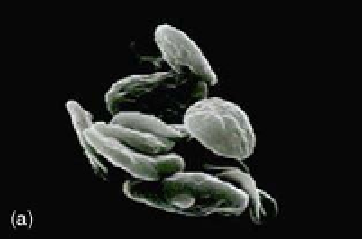Biomedical Engineering Reference
In-Depth Information
FIGURE 14.29
(a) Normal platelet. (b) Activated platelet.
fragments, they contain many structures that are critical to stop bleeding. They contain pro-
teins on their surface that allow them to stick to breaks in the blood vessel wall and also to
stick to one another. They contain granules that can secrete other proteins required for cre-
ating a firm plug to seal blood vessel breaks. Also, platelets contain proteins similar to mus-
cle proteins that allow them to change shape when they become sticky. Figures 14.29a and b
depict a normal platelet and an activated platelet. The normal platelet is shaped like a plate,
thus lending itself to the name. An activated platelet extends tentacles to allow it to adhere
to surfaces where bleeding exists.
The measurement of fluid viscosity is conducted with a device known as a viscometer.
For liquids with viscosities that vary with flow conditions, an instrument called a rheometer
is used. Viscometers only measure viscosity under one flow condition. In general, either the
fluid remains stationary and an object moves through it, or the object is stationary and the
fluid moves past it. The drag caused by relative motion of the fluid and a surface is a mea-
sure of the viscosity.
A falling sphere viscometer is one of the simpler types of viscometers. It is based on
Stokes's law, which describes the flow of a fluid past a sphere in a vertical tube, where the
flow is very slow. A sphere of known size and density is allowed to descend through the liq-
uid. If correctly selected, it reaches terminal velocity, which can be measured by the time it
takes to pass two marks on the tube. Knowing the terminal velocity, the size and density of
the sphere, and the density of the liquid, Stokes's law can be used to calculate the viscosity
of the fluid. A series of steel ball bearings of different diameters are normally used in the
classic experiment to improve the accuracy of the calculation. Stokes's law is given as
F
¼
6p
r
v
where
F
¼
the frictional force
r
¼
the radius of the spherical object
¼
the fluid viscosity
v
¼
the particle's velocity
An example of a functional relationship for a falling sphere viscometer is shown in
Figure 14.30.
Since blood is opaque, sensors within the tube indicate when the sphere passes points
along the tube. Another type of viscometer is the
Couette
or concentric cylinder viscometer.



